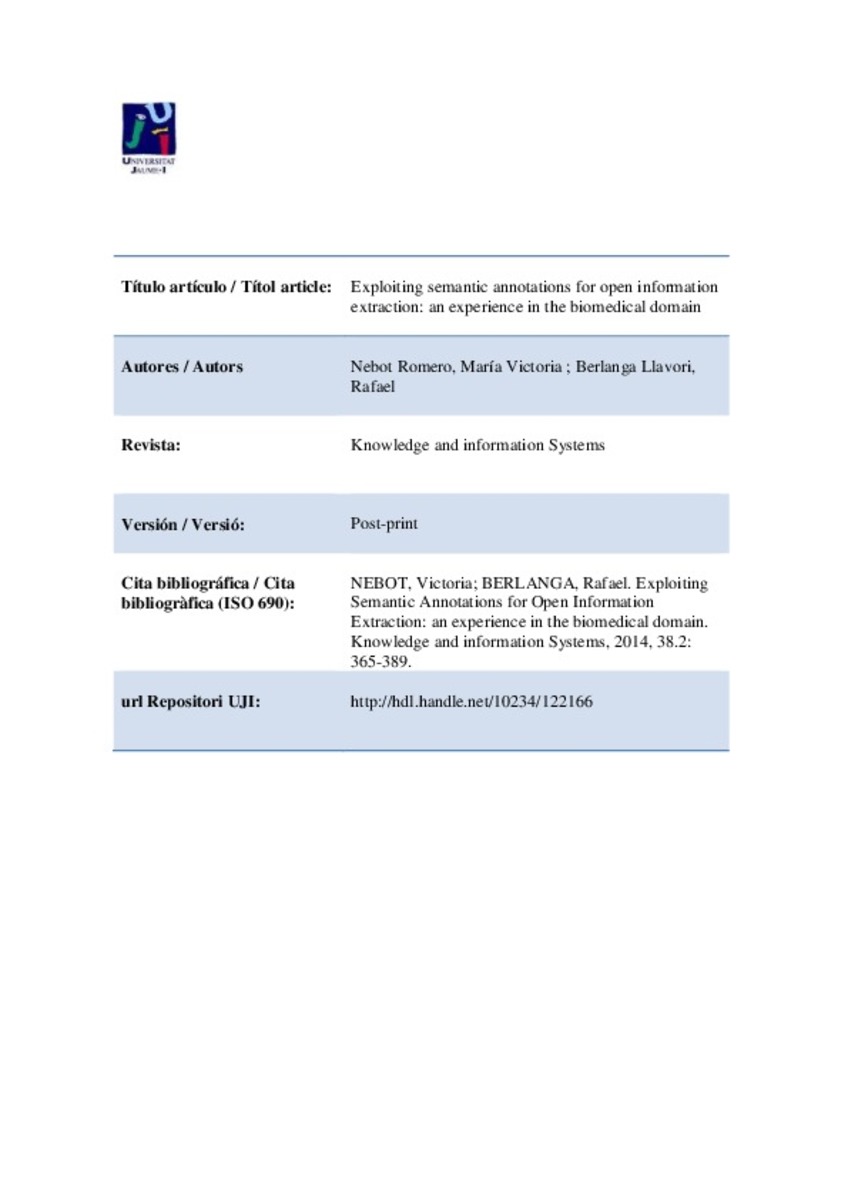Mostrar el registro sencillo del ítem
Exploiting semantic annotations for open information extraction: an experience in the biomedical domain
| dc.contributor.author | Nebot Romero, Victoria | |
| dc.contributor.author | Berlanga Llavori, Rafael | |
| dc.date.accessioned | 2015-05-29T09:34:32Z | |
| dc.date.available | 2015-05-29T09:34:32Z | |
| dc.date.issued | 2014 | |
| dc.identifier.citation | NEBOT, Victoria; BERLANGA, Rafael. Exploiting Semantic Annotations for Open Information Extraction: an experience in the biomedical domain. Knowledge and information Systems, 2014, 38.2: 365-389. | ca_CA |
| dc.identifier.issn | 0219-1377 | |
| dc.identifier.issn | 0219-3116 | |
| dc.identifier.uri | http://hdl.handle.net/10234/122166 | |
| dc.description.abstract | The increasing amount of unstructured text published on the Web is demanding new tools and methods to automatically process and extract relevant information. Traditional information extraction has focused on harvesting domain-specific, pre-specified relations, which usually requires manual labor and heavy machinery; especially in the biomedical domain, the main efforts have been directed toward the recognition of well-defined entities such as genes or proteins, which constitutes the basis for extracting the relationships between the recognized entities. The intrinsic features and scale of the Web demand new approaches able to cope with the diversity of documents, where the number of relations is unbounded and not known in advance. This paper presents a scalable method for the extraction of domain-independent relations from text that exploits the knowledge in the semantic annotations. The method is not geared to any specific domain (e.g., protein–protein interactions and drug–drug interactions) and does not require any manual input or deep processing. Moreover, the method uses the extracted relations to compute groups of abstract semantic relations characterized by their signature types and synonymous relation strings. This constitutes a valuable source of knowledge when constructing formal knowledge bases, as we enable seamless integration of the extracted relations with the available knowledge resources through the process of semantic annotation. The proposed approach has successfully been applied to a large text collection in the biomedical domain and the results are very encouraging. | ca_CA |
| dc.description.sponsorShip | The work was supported by the CICYT project TIN2011-24147 from the Spanish Ministry of Economy and Competitiveness (MINECO). | ca_CA |
| dc.format.extent | 24 p. | ca_CA |
| dc.format.mimetype | application/pdf | ca_CA |
| dc.language.iso | eng | ca_CA |
| dc.publisher | Springer | ca_CA |
| dc.relation.isPartOf | Knowledge and information Systems, 2014, 38.2 | ca_CA |
| dc.rights | © Springer International Publishing AG | ca_CA |
| dc.rights.uri | http://rightsstatements.org/vocab/InC/1.0/ | * |
| dc.subject | Unsupervised IE | ca_CA |
| dc.subject | Relation extraction | ca_CA |
| dc.subject | Semantic annotation | ca_CA |
| dc.subject | Biomedical domain | ca_CA |
| dc.title | Exploiting semantic annotations for open information extraction: an experience in the biomedical domain | ca_CA |
| dc.type | info:eu-repo/semantics/article | ca_CA |
| dc.identifier.doi | http://dx.doi.org/10.1007/s10115-012-0590-x | |
| dc.rights.accessRights | info:eu-repo/semantics/openAccess | ca_CA |
| dc.relation.publisherVersion | http://link.springer.com/article/10.1007%2Fs10115-012-0590-x | ca_CA |
| dc.type.version | info:eu-repo/semantics/acceptedVersion |
Ficheros en el ítem
Este ítem aparece en la(s) siguiente(s) colección(ones)
-
LSI_Articles [361]
Articles de publicacions periòdiques escrits per professors del Departament de Llenguatges i Sistemes Informàtics







